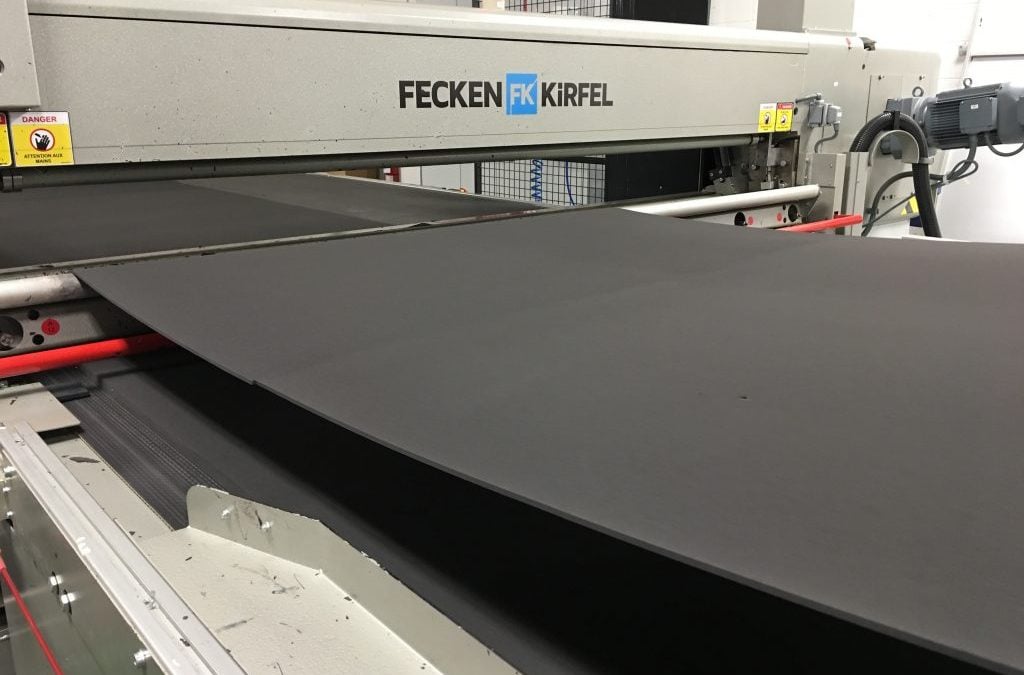PE foams are typically manufactured in sheets or blocks which may not be perfectly flat due to
the expansion process used to create the foam. Even when removing the outer “skins”, whatever
high or low spots were on the foam will remain.
Elastomeric foams are made from a blend of various polymers and can present some unique
challenges. They are flexible and deformable which can make it more difficult to maintain
consistent thickness during skiving. Some elastomers have a higher coefficient of friction which
can affect how they interact with the cutting blade and lead to variations in thickness.
Our equipment is very accurate, and our processes help ensure this accuracy. However, it is
important to note that the final thickness tolerances are not solely a function of the machine
performance but are also influenced by the unique characteristics of the material. If strict
tolerances are necessary for your application, contact us for available solutions.
Terminology:
Splitting: Progressive horizontal cutting of the material in half to reach the required dimension
Skiving: The process of cutting a thin sheet from a thicker block or bun
Skin: Outer layer or surface of foam formed during manufacturing that is typically denser
Looping: The process of making continuous rolls out of buns that have been seamed together to
create a loop. This is done on vacuum table skivers designed for this process.
Leveling: The process of leveling out the thickness variation within a sheet.
Temperature Factors:
Changes in temperature can have pronounced effects on thermoplastics. Exposure to
heat induces expansion in these materials, while cooling prompts contraction. Additionally, a
notable change occurs in their physical properties, with an increase in temperature making the
foam softer, and a decrease causing it to stiffen.
Types of skiving:
Roller Splitting/Skiving: The material is compressed between two rollers to push it through a
fixed ultra sharp knife edged blade. Thickness is controlled by the relative distance of the
rollers from the blade and the amount of compression required to push the foam through the
blade.
Characteristics
|
Drawbacks and Limitations
|
Vacuum Table Skiving / Looping: Material is held flat to a table using air suction, and the table
is passed through an ultra-sharp knife edged blade. Thickness is controlled by the relative
distance of the blade from the table. The first pass(s) will level the material. The table will
continue moving, with the blade dropping a defined thickness each time until done.
Characteristics
|
Drawbacks and Limitations
|
Skiving Tolerances
While there are ASTM standards that address skiving tolerances, most notably D4819, Standard
Specification for Flexible Cellular Materials Made from Polyolefin Plastics. Worldwide Foam
has chosen to define its own standard tolerances that are tighter than those in the ASTM.
Tolerances requested that are tighter than the below will need to be custom quoted.
Roller Splitter/Skiver Tolerances
Thickness in Inches |
Tolerance in Inches |
| .125 – .3125 | +/- .03125 |
| .32 – .875 | +/- 10% of thickness |
| .88 – 2 | +/- .094 |
| Greater than 2” | +/- .125 |
| 2” single stage designated with the R code | 1.94 +/- .06 (2” max) |
Vacuum Table – PE Tolerances
Thickness in Inches |
Tolerance in Inches |
| .079 – .75 | +/- .03125 |
| .76 – 1 | +/- .0625 |
Note: Vacuum Table is limited to 4lb density and below and 1” maximum in most
circumstances.
Vacuum Table – Elastomeric Tolerances
Thickness in Inches |
Tolerance in Inches |
| <0.09375” | +.03”/-.015” |
| >0.09375”-.3125” | +/-.03” |
| >0.3125”-0.5” | +/-.045” |
| >0.5”-0.75 | +/-.06” |
| >.75”-0.875” | +/-0.075” |
| >0.875”-1” | +/-.09” |
| >1”-1.25” | +/-0.125” |
| >1.25”-1.5” | +/-0.15” |
| >1.5”-2” | +/-0.18” |

